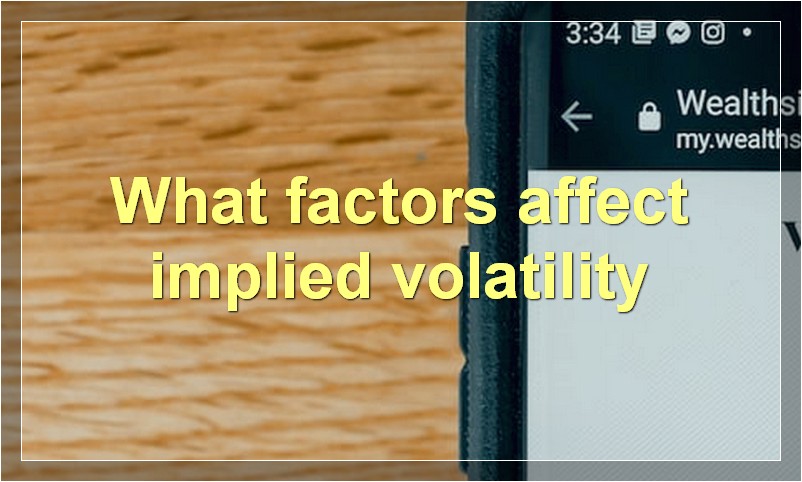If you’re new to the world of implied volatility, this beginner’s guide is for you. In this guide, we’ll cover the basics of what implied volatility is and how it can be used to help you make better-informed trading decisions.
What is an implied volatility chart
An implied volatility chart is a graphical representation of the relationship between options’ implied volatilities and the underlying asset’s price. The purpose of an implied volatility chart is to help options traders understand how changes in the underlying asset’s price affect the option’s premium (or price).
Implied volatility is a measure of the expected fluctuations in an underlying asset’s price. It is derived from the prices of options on that asset. The higher the implied volatility, the greater the expected price swings.
An implied volatility chart plots implied volatility against the underlying asset’s price. The x-axis represents the underlying asset’s price, while the y-axis represents the option’s implied volatility.
Options traders use implied volatility charts to find trading opportunities. They look for points where the option’s premium is high relative to its implied volatility. This indicates that the option is overpriced and may be ripe for selling. Conversely, they also look for points where the option’s premium is low relative to its implied volatility. This indicates that the option is underpriced and may be ripe for buying.
How is implied volatility calculated

Implied volatility is a measure of the expected volatility of a security’s price. It is derived from the prices of options on the security. The higher the implied volatility, the greater the expected price movements of the security.
Implied volatility is calculated using a mathematical model known as the Black-Scholes model. This model takes into account factors such as the time to expiration of the option, the strike price, the underlying security’s price, and interest rates.
The Black-Scholes model is used to calculate a theoretical value for an option. This value is then compared to the market price of the option to determine the implied volatility.
Implied volatility is important because it can be used to gauge investor sentiment. A high level of implied volatility indicates that investors are expecting large price movements in the underlying security. A low level of implied volatility indicates that investors are expecting small price movements.
What is the difference between historical and implied volatility
Volatility is a measure of how much the price of a security, derivative, or index fluctuates. There are two types of volatility: historical and implied. Historical volatility is based on past price movements, while implied volatility is based on future price movements that are implied by the market.
Historical volatility is calculated using a mathematical formula that takes into account the standard deviation of past prices. This type of volatility can be useful for making comparisons between securities. For example, if one stock has a historical volatility of 20% and another stock has a historical volatility of 30%, the first stock is less volatile.
Implied volatility is based on option prices. It is calculated using a mathematical formula that takes into account the price of the underlying security, the strike price of the option, the time to expiration, the interest rate, and the dividends. This type of volatility can be useful for making investment decisions. For example, if the implied volatility of a stock is high, it means that the market expects the stock to be volatile in the future.
Why is implied volatility important
Implied volatility is important because it is a measure of the market’s expectations for future stock price volatility. It is used by options traders to help them determine the appropriate premium to pay for an option contract.
How do I interpret an implied volatility chart
When looking at an implied volatility chart, there are a few things that you will want to take into account. The first is the shape of the curve. A steep curve indicates that the market is expecting a lot of movement in the underlying security, while a flat curve indicates that the market is expecting relatively little movement. The second thing to look at is the level of the curve. A high level indicates that the market is expecting greater volatility than usual, while a low level indicates that the market is expecting less volatility than usual.
One way to interpret an implied volatility chart is to compare it to historical volatility. If the current level of implied volatility is higher than historical volatility, it may be an indication that the market is expecting greater than normal movements in the underlying security. Conversely, if the current level of implied volatility is lower than historical volatility, it may be an indication that the market is expecting less than normal movements in the underlying security.
Another way to interpret an implied volatility chart is to compare it to the current price of the underlying security. If the current level of implied volatility is higher than the current price, it may be an indication that the market is expecting the price to rise. Conversely, if the current level of implied volatility is lower than the current price, it may be an indication that the market is expecting the price to fall.
What factors affect implied volatility

Investors often use implied volatility to gauge how nervous or calm the market is. They can do this by looking at the CBOE Volatility Index (VIX), which is a measure of the S&P 500’s expected volatility over the next 30 days. The VIX is sometimes referred to as the “fear index.”
Implied volatility is affected by a number of factors, including supply and demand, the underlying security’s price, and the length of time until expiration. In general, when there is more demand for an option, the price of that option will increase, and implied volatility will rise. When there is less demand for an option, the price of that option will decrease, and implied volatility will fall.
The underlying security’s price also has an impact on implied volatility. When the price of the underlying security goes up, implied volatility usually increases as well. This is because investors are willing to pay more for options when the underlying security is expensive. Conversely, when the price of the underlying security goes down, implied volatility usually decreases as well.
Finally, the length of time until expiration can affect implied volatility. Options that are about to expire are typically less volatile than options with longer expiration dates. This is because there is less time for something to happen that would cause the price of the option to move sharply up or down.
How does implied volatility impact options prices
Implied volatility is a measure of the expected volatility of a security’s price. It is derived from the prices of options on that security. The higher the implied volatility, the higher the price of the options.
Options are often used by investors to hedge against future events. For example, if an investor expects a stock to decline in value, they may purchase put options to protect themselves from losses. The price of the put option will increase as the expected volatility of the stock increases.
Implied volatility can also be used to profit from future events. If an investor expects a stock to increase in value, they may purchase call options. The price of the call option will increase as the expected volatility of the stock increases.
options are derivative contracts that give the holder the right, but not the obligation, to buy or sell an underlying asset at a specified price on or before a certain date. Options are traded on many different underlying assets, including stocks, commodities, currencies, and indexes.
The most important factor in determining the price of an option is the underlying asset’s volatility. Volatility is a measure of how much the price of an asset fluctuates over time. The more volatile an asset is, the higher the price of its options will be.
Implied volatility is a measure of the expected volatility of an asset’s price. It is derived from the prices of options on that asset. The higher the implied volatility, the higher the price of the options.
Investors use options to hedge against future events or to profit from them. The price of an option depends on the underlying asset’s volatility. The more volatile an asset is, the higher its options will be priced.
Is higher implied volatility always better for option sellers
No, higher implied volatility is not always better for option sellers. In fact, it can be quite the opposite. When implied volatility is high, it means that the market is expecting a lot of movement in the underlying asset, which can be bad news for option sellers.
How can I use an implied volatility chart to my advantage
If you’re a trader, implied volatility is an important concept to understand. It’s a measure of how much the market is expecting a stock to move, and it can have a big impact on your profits.
An implied volatility chart can be a useful tool for finding trading opportunities. By looking at the shape of the curve, you can get an idea of where the market is expecting a stock to move. If the curve is steep, that means the market is expecting a lot of movement. This can be a good time to buy straddle options or sell puts and calls.
If the curve is flat, that means the market isn’t expecting much movement. This can be a good time to buy options with long expiration dates or sell options that are about to expire.
Of course, implied volatility is just one factor to consider when making trading decisions. But it’s an important one, and an implied volatility chart can be a helpful tool in your arsenal.
What are some common strategies for trading implied volatility
Implied volatility is the market’s expectation of future volatility. It is important for options traders to understand common strategies for trading implied volatility because it can have a significant impact on the price of options. Some common strategies for trading implied volatility include buying and selling options, selling options premium, and hedging.

